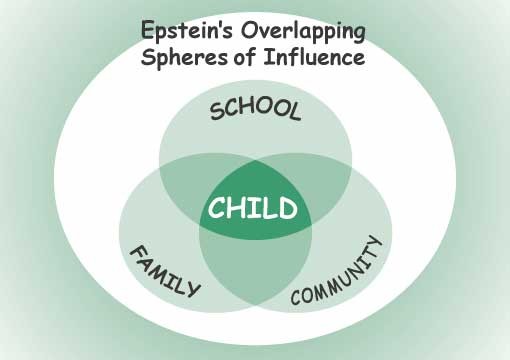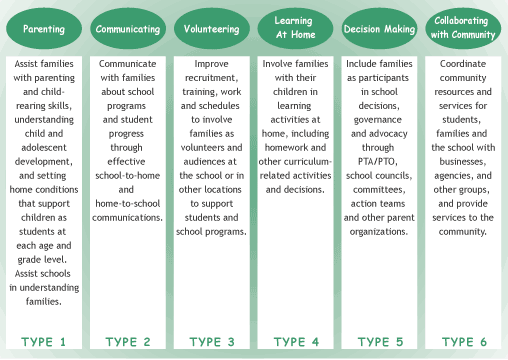|
|
||||||||||||||||||||||||||||||||||||||||||||||||||||||||||||||||||||||||||||||||||||||||
|
MISSION STATEMENT - To enhance our children's learning and development by being a proactive resource in promoting, strengthening and celebrating the partnership that exists between Schools, Families and the Naperville Community. For more information contact the Office of Community Relations at 630-420-6815. BACKGROUND During the winter of the 1995-96 school year, a focus group of parents and community members met to discuss how the District 203 staff could improve communication between our schools, families and community members. A recommendation from the focus group suggested a need for more parent involvement in our schools. As a result, the District researched different Parent Involvement models throughout school districts in the U.S.
Representatives attended a seminar at The Institute for Development of
Education Activities where they were introduced to the Joyce Epstein
Framework of Six Types of Involvement as a foundation to promote better
parent involvement in our district. The District
adopted this model and the Parent Involvement Core Team (or School Family
Community Partnership as it is now called) was initiated during the summer
of 1996. SFCP teams at the individual schools were organized during
the fall of 1996. Today, there are over 260 parents, teachers,
administrators and community members actively involved in this initiative
across our 21 schools sponsoring 100+ individual programs. Since the
start of this initiative, many of our schools' best practices have been
featured in the National Network of Partnership Schools annual Promising
Partnership Practices book. In addition, three of our schools have
received the National Network's Partnership School Award for Excellence and
the District Core Team has received the Network's District Award for
Excellence four years in a row. DR. JOYCE EPSTEIN'S MODEL In her research report
titled Caring for the Children We Share Dr. Epstein states, "The way
schools care about children is reflected in the way schools care about the
children's families. If educators view children simply as students,
they are likely to see the family as separate from the school. That
is, the family is expected to do its job and leave the education of children
to the schools. If educators view students as children, they
are likely to see both the family and the community as partners with the
school in children's education and development. Partners recognize
their shared interest in and responsibilities for children, and they work
together to create better programs and opportunities for students.
There are
many reasons for developing school, family, and community partnerships.
They can improve school programs and school climate, provide family services
and support, increase parents' skills and leadership, connect families with
others in the school and in the community, and help teachers with their
work. However, the main reason to create such partnerships is to help
all youngsters succeed in school and in later life. When parents,
teachers, students, and others view one another as partners in education, a
caring community forms around students and begins its work. Epstein's Overlapping Spheres of Influence The
overlapping spheres of influence recognize that there are three major
contexts in which students learn and grow - the family, the school, and the
community. In this model, there are some practices that schools,
families, and communities conduct separately and some they conduct jointly
in order to influence children's learning and development. The model locates the student at the center. The inarguable fact is that students are the main actors in their education, development, and success in school. School, family, and community partnerships cannot simply produce successful students. Rather, partnership activities may be designed to engage, guide, energize, and motivate students to produce their own successes. The assumption is that if children feel cared for and encouraged to work hard in the role of student they are more likely to do their best to learn to read, write, calculate, and learn other skills and talents and to remain in school.
Epstein's Six
Types of Involvement A framework of six major
types of involvement has evolved from many studies and from many years of
work by educators and families in elementary, middle, and high schools.
The framework allows schools to develop more comprehensive programs of
school, family and community partnership.
Each type of
involvement induces many different practices of partnership and
implementation of partnerships will vary. However, if done well, all
can positively impact students, teachers and parents. A well-designed
and well-implemented program will include all six types of involvement to
some degree and be linked to the individual school goals.
PROGRAM IDEAS Individual schools develop custom programs within the six types of involvement to help achieve their specific school improvement goals and provide opportunities for parents and community members to become active partners in the education of their children at each grade level. Listed below are a few program examples from six of our schools. Click on each "Type of Involvement" below for a listing of District 203 programs (PDF format). Type 1 Parenting - Maplebrook Elementary School - Parenting Seminars with Core Inc. Counseling Goal of Activity - To provide Maplebrook families with the necessary resources to enhance their parenting skills that will ultimately maximize children's learning and social growth. Description of Activity - Maplebrook conducted monthly Parenting Seminars with Core Inc. Counseling to first access the needs of parents and families and then to address topics of mutual interest and concern. Type 2 Communication - Washington Junior High School - Sixth Grade Family Picnic Goal of Activity - To ease the transition to middle school for incoming 6th graders and their families by hosting a fun activity early in the school year. Description of Activity - WJHS hosted an informal picnic for all 6th grade students and their families as a way to informally meet all the teachers and staff. Initially, teachers planned/worked the picnic, but parents now assume that responsibility to allow teachers to mingle with all the families. Type 3 Volunteering - Meadow Glens Elementary - International Night Goal of Activity
|
||||||||||||||||||||||||||||||||||||||||||||||||||||||||||||||||||||||||||||||||||||||||
| Name | Location | |
| Pat Todd | Ellsworth - Parent | ptodd131@aol.com |
| Sandy Wunderlich | Kingsley - Parent | srwunderlich@aol.com |
| Christine Johnson | Highlands - Asst. Principal | cjohnson@ncusd203.org |
| Tom Paulsen | Assoc. Superintendent Operations k-12 | tpaulsen@ncusd203.org |
| Michael Jaensch | Madison - Parent | mjaensch@dellepro.com |
| Paul Schmidt | Jefferson - Principal | pschmidt@ncusd203.org |
| Jane Wernett | Highlands & KJHS - parent | wwernette@aol.com |
| Jeff VanHarlingen | Madison - Teacher | jvanharlingen@ncusd203.org |
| Jim Caudill | NCHS - Principal | jcaudill@ncusd203.org |
| Sheila Sarovich | NNHS - Parent | elle-la@lycos.com |
| Linda Gross | NCHS - Guidance | lgross@ncusd203.org |
| Patti McIntire | NNHS - Social Worker | pmcintire@ncusd203.org |
|
Co-Chairs Terri Stevens and Karen Currier |
||
|
Director of Community
Relations Nina Menis |
||
|
Associate
Superintendent Instruction K-12 Lenore Johnson |
||
|
Assistant Superintendent for
Special Education Kitty Murphy |
||
|
District 203 Superintendent Dr. Alan Leis |
||
|
School Board Representative Debbie Shipley |
||
|
Business Community
Representative Julie Lichter |
||
|
Executive Board Member of
General Home & School Dagmar Porcelli |
||
RESOURCES
If you are looking for more
ideas for your SFCP team, consider checking out the following resources:
|
Resource |
Author/Sponsor |
Location |
|
Handbook for Action This book provides a step-by-step guide to developing a comprehensive program of partnership. |
Dr. Epstein NNPS |
Each school received a copy of this book at the Orientation in September 2002. There are extra copies located in the Community Resource Room. |
|
Promising Partnership Practices A book detailing 70+ partnership programs that the National Network views as best practices. |
Dr. Epstein NNPS |
Each school received a copy of the 2003 edition at the Orientation in September 2003. Past editions are located in the Community Resource Room. The information can also be downloaded from the NNPS web site. |
|
NNPS Web Site This web site provides a wide variety of information about the National Network of Partnership Schools. |
Dr. Epstein NNPS |
|
|
District 203 SFCP Best Practices A summary of each school's best practice for the 2002-2003 school year. |
Core Team |
Each school received a copy at the Celebration breakfast in May 2003. Additional copies are available in the Community Resource Room.
|
|
A database containing 100+ program ideas organized by Epstein's TYPE of Involvement and grade level. It was updated in May 2003 and includes programs from all 21 schools. An activity description is provided together with the person to contact, via phone/email for further information. |
Core Team |
Each school received a copy in their 2003-2004 Training Binder which was distributed at the September 2003 Orientation. Additional copies are available from the District 203 Community Relations Department or you can download it directly from this web site. |
|
Business Partner Development This folder provides information on how to develop a business partnership for your school.
|
Business Community Partnership for Education |
Folders are available from the District 203 Community Relations Department. |
|
Community Resource Room This room contains a wide variety of books, videos and training binders on subjects from leadership to parenting. The resources can be 'checked out' by any Action Team member. |
Community Relations Department |
Administration Building |
Revised: 01/25/2005
![]()
Please read NCUSD's Privacy
Statement and send comments to the Webmaster.
IMPORTANT: Click
the 'Reload' or 'Refresh' button on your browser to ensure viewing of latest
information.
NOTE: Acrobat Reader is required to view some documents.
Download Acrobat Reader FREE: ![]()

